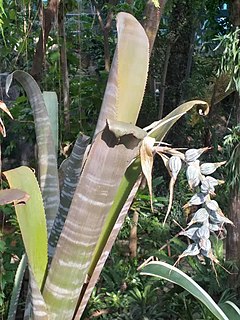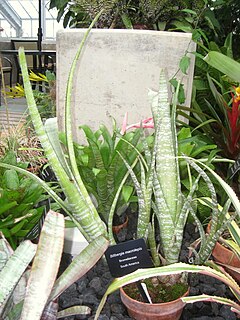
The Bromeliaceae is a family of monocot flowering plants of 75 genera and around 3590 known species native mainly to the tropical Americas, with a few species found in the American subtropics and one in tropical west Africa, Pitcairnia feliciana.

Billbergia is a genus of flowering plants in the family Bromeliaceae, subfamily Bromelioideae. The genus, named for the Swedish botanist, zoologist, and anatomist Gustaf Johan Billberg, is divided into two subgenera: Billbergia and Helicodea. They are native to forest and scrub, up to an altitude of 1,700 m (5,577 ft), in southern Mexico, the West Indies, Central America and South America, with many species endemic to Brazil.

Billbergia pyramidalis, commonly known as the flaming torch and foolproof plant, is a species of bromeliad that is native to northern South America and parts of the Caribbean. It was first described by John Sims, and got its current name by John Lindley.

Billbergia alfonsi-joannis is a species of bromeliad in the flowering plant genus Billbergia. This species is endemic to southeastern Brazil, from Espírito Santo to Santa Catarina.
Billbergia cardenasii is a species in the genus Billbergia. This species is endemic to Bolivia. The billbergia cardenasii has clear yellow petals and equal sepals.
Helicodea is a subgenus of the genus Billbergia in the flowering plant family Bromeliaceae. Species are distinguishable by the tightly recurved 'clock spring' flower petals, unlike other billbergias where the petals are flared.

Billbergia leptopoda is a plant species in the genus Billbergia. This species is endemic to Brazil.

Billbergia macrocalyx is a plant species in the genus Billbergia. This species is endemic to Brazil.
Billbergia morelii is a plant species in the genus Billbergia. This species is endemic to Brazil.
Billbergia sanderiana is a plant species in the genus Billbergia. This species is endemic to Brazil.

Billbergia saundersii is a species in the genus Billbergia. This species is endemic to Brazil.
Billbergia tweedieana is a species of flowering plant in the Bromeliaceae family. This species is endemic to southeastern Brazil.

Billbergia amoena is a plant species in the genus Billbergia. This species is endemic to Brazil but widely cultivated elsewhere as an ornamental.
Billbergia brasiliensis is a species in the genus Billbergia. This species is native to Bolivia and Brazil.

Billbergia distachya is a plant species in the genus Billbergia. The species is native to Brazil.

Billbergia vittata is a plant species in the genus Billbergia. This species is native to Brazil.
Billbergia zebrina is a species in the genus Billbergia. This species is native to Brazil, Argentina, Uruguay, and Paraguay.

Billbergia macrolepis is a species in the genus Billbergia. This species is native to Costa Rica, Panama, Colombia, Ecuador, Venezuela, and Guyana.
Billbergia rosea is a species in the genus Billbergia. This species is native to Venezuela and to the Island of Trinidad.
Athis axaqua is a moth in the Castniidae family. It is found from north-central to south-western of Venezuela and might reach south-eastern Colombia.










